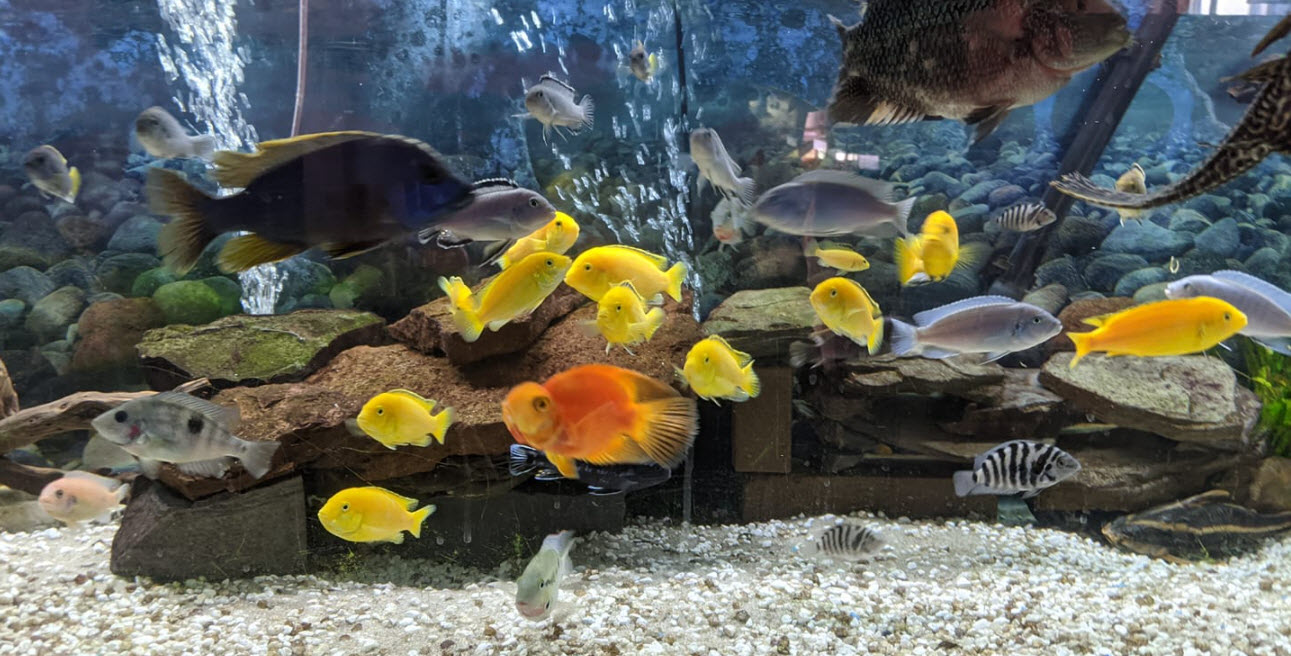
References on Ammonia and Surface Area
If one is only concerned with ammonia oxidation, as little as five square feet of static submerged biomedia surface per metabolic pound of fish can be used to produce safe levels of ammonia and nitrite for tropical fish.
A reference is useful here:
“Simply put, if you do a good job of removing the solids from the system with the mechanical filter, the amount of surface area present in the biofilter will determine how much bacteria you can grow, how much you can feed the fish, and, thus, how many pounds of fish the system can hold. A general rule of thumb is that it takes at least 5 square feet of biomedia to handle 1 pound of fish being fed at 2 percent of body weight per day.”
(“Constructing a Simple and Inexpensive Recirculating Aquaculture System (RAS) for Classroom Use”, David Cline, Southern Research Aquaculture Center, Auburn University, 2005).
This article recommends 5 ft2 of effective filter media surface per metabolic pound of fish. But this is for tilapia and catfish, which are very tolerant of bad water including moderate levels of ammonia and nitrite. And it is for a submerged static filter. The important point here is that it is the square feet of surface area available which is important in biofiltration.
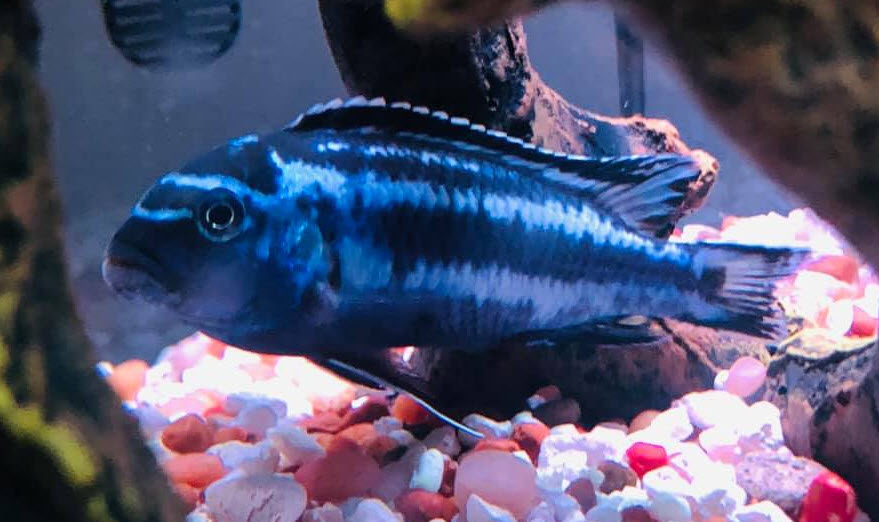
If a pound of fish is fed at a 2% of body weight per day of dry fish food one needs to calculate the rough amount of ammonia per day this will produce to look at further references:
- One pound is 454 grams.
- A typical feed rate is 2% of weight
- 2% of 454 grams (one pound) is 9 grams
- Fish food is typically 40% protein.
- Protein is typically 17% nitrogen. 9 x 0.4 x 0.17 = 0.612 grams nitrogen per pound of fish per day.
- NH4 to N ratio is 19/15 = 1.266
- 1.266 x 0.612 = 0.775 grams ammonia per pound of fish per day.
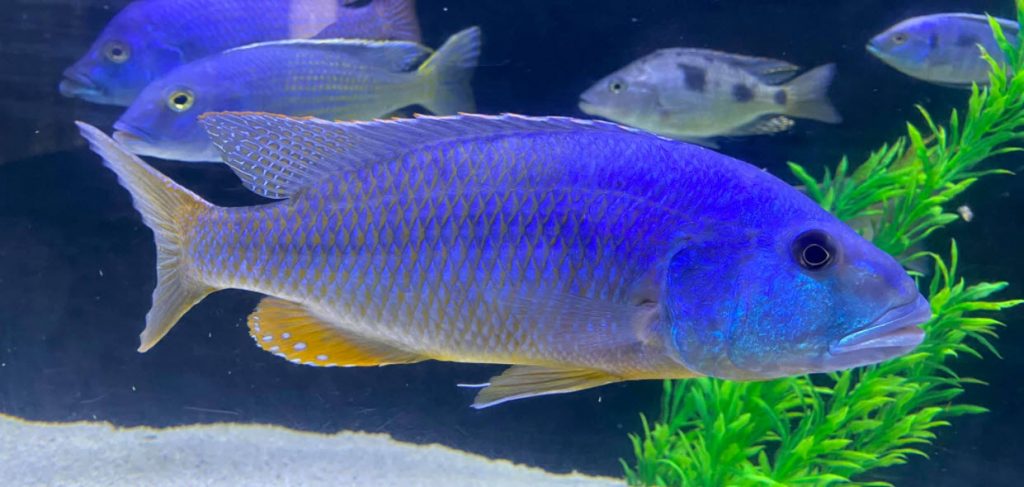
The University of Arizona in one of their materials (https://ag.arizona.edu/azaqua/ista/ISTA7/RecircWorkshop/Workshop%20PP%20%20&%20Misc%20Papers%20Adobe%202006/7%20Biofiltration/Nitrification-Biofiltration/Biofiltration- Nitrification%20Design%20Overview.pdf) mentions the average ammonia removal rate on average of 0.5 gram ammonia per square meter per day. Since one square meter is roughly 11 square feet this is 0.775/0.5 = 1.55 pounds of fish per 11 square feet. 11/1.55 = 7 square feet per metabolic pound of fish per day for ONLY ammonia removal. This is quite close to the 5 square feet figure in the first reference.
Summerfelt, 2006 (“Design and Management of Conventional Fluidized-Sand Biofilters”) achieved an average removal of 0.3 grams ammonia per square meter. This is roughly 0.775/.3 = 2.58, 11/2.58 = 4 square feet per metabolic pound of fish per day for ONLY ammonia removal. Again, this is quite close to the 5 square feet figure in the first reference.
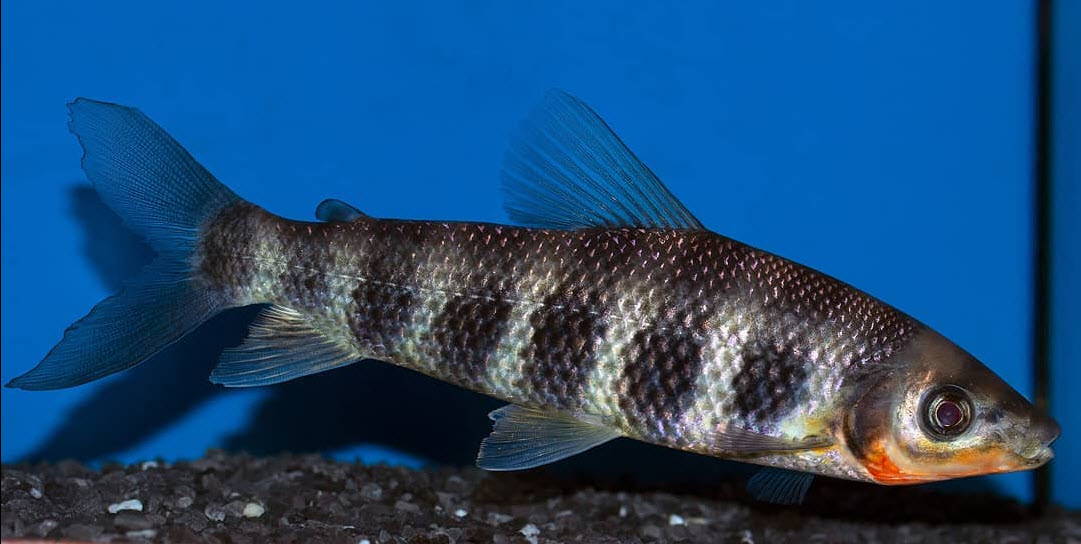
The Food and Agriculture Organization of the United Nations in its booklet available on the website www.fao.org mentions the ammonia removal rate varying between 0.2 and 2 grams per square meter of specific surface. 0.775/0.2 = 3.875, 11/3.875 = 2.8 to 28 square feet per metabolic pound of fish per day for ONLY ammonia removal. If 2.8 to 28 is considered a binomial distribution the mean will be very close to the 5 square feet figure in the first reference.
All these materials are for aquaculture operations. So one might want a reference which talks about aquariums. Grommen (“An Improved Nitrifying Enrichment to Remove Ammonium and Nitrite from Freshwater Aquaria Systems”) shows in his study of aquariums an average removal of 0.47 grams of ammonia per square meter of media in aquariums. 0.775/0.47 = 1.65, 11/1.65 = 6.7 square feet per metabolic pound of fish per day for ONLY ammonia removal. This is quite close to the 5 square feet figure in the first reference.
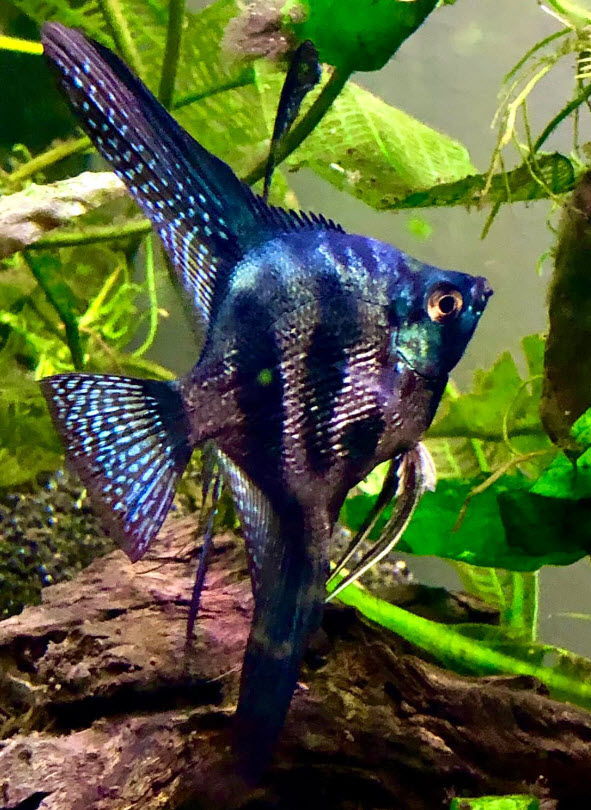
This makes 6 references which come in at about very roughly the 5 feet per pound figure. So Ammonia oxidation is easy! We will use the following “rule”:
.
One Metabolic Pound Of Fish Needs 5 Square Feet of Biomedia Surface Area for Ammonia Oxidation
.
This is with a caveat. This is ONLY a submerged bed figure. A fluidized bed might need only two square feet while a trickle filter might need ten square feet.
Another reference gives 1.7 square foot of biomedia surface in a fluidized bed required for ammonia oxidation for one pound of fish (“Design and Operation of Moving Bed Biofilm Reactor Plants for Very Low Effluent Nitrogen and Phosphorus Concentrations”, Rusten, 2007). The difference between 1.7 and 5 reflects the increased efficiency of a fluidized bed.
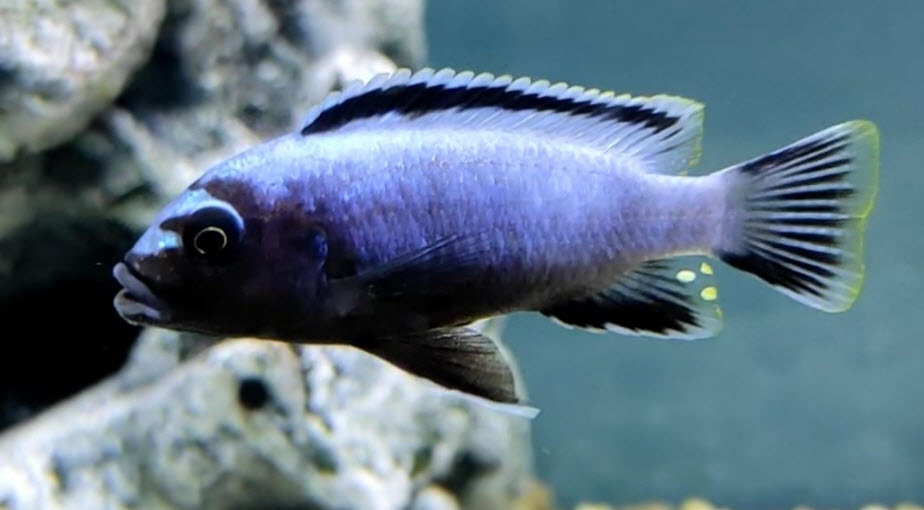
Crystal Clear Water
But achieving crystal clear water is a different story than ammonia and nitrite. One metabolic pound of fish needs roughly 100 square foot of biomedia surface area to produce fairly clear water. This is a very important rule. It is paramount in fish keeping.
.
One Metabolic Pound Of Fish Needs 100 Square Feet of Biomedia Surface Area for Healthy, Crystal Clear Water
.
This amount of biomedia give no nitrites, no ammonia, good water clarity and good fish health. It is twenty times the level required for good ammonia oxidation in a submerged stationary media filter like a canister filter.
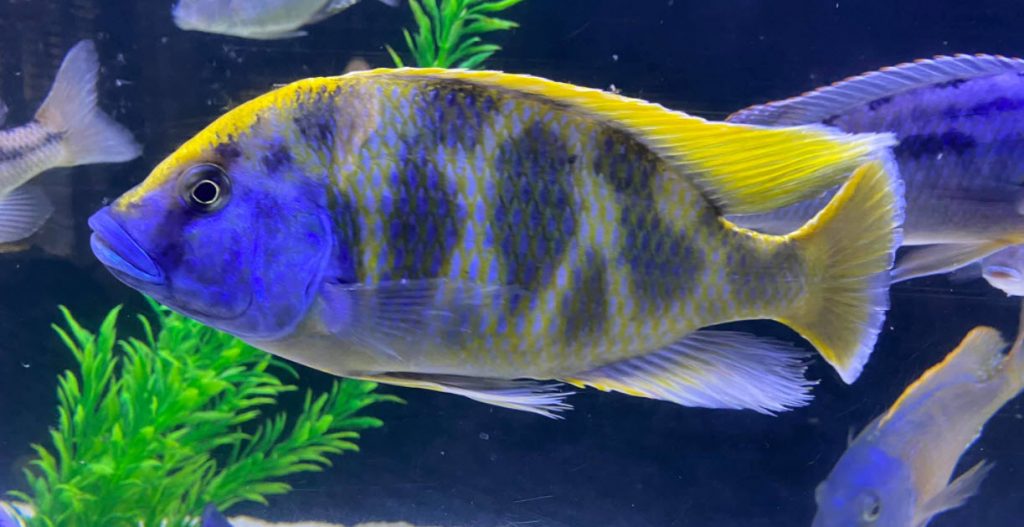
A Continuum
There is a very rough geometric progression when it comes to water parameters and surface area in a filter. This can easily be put in a table form for static submerged media:
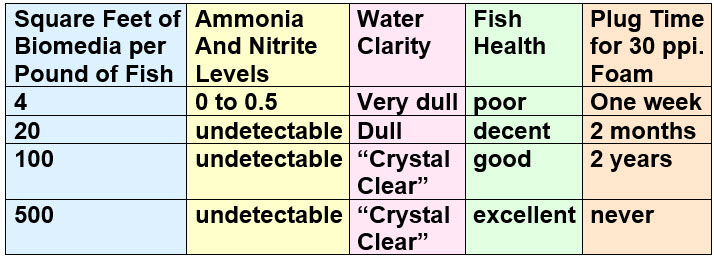
Note that the 4-20-100-500 progression here is called a geometric relationship (multiply the preceding number by five) and is quite common in natural systems.
- All this is predicated on cleaning the biomedia only lightly when the flow noticeably slows down, cleaning the biomedia removes the beneficial bacteria which have slowly built up.
- This is for a canister filter (i.e. submerged static media). A fluidized bed filter is two to five times more efficient while a trickle filter is half to one fourth as efficient.
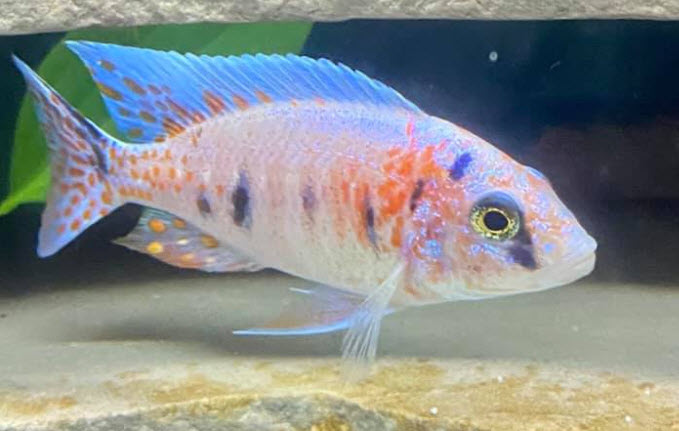
Note this surface area rule is supported in the literature (“Understanding Biological Surface Area in Aquaponics”, Michael, 2016).
“Remember: as an absolute minimum, your system needs at least: 2.5 ft2 of biological surface area/gallon of water (at low stocking densities and low feeding rates). For a healthier system, we would recommend: 10 ft2/gallon of water OR 100 square feet per pound of fish.”
Media Square Feet per Cubic Foot
The basic calculation for biofiltration depends on two factors: 1, the type of media 2, the volume of that media. A master chart on that is:
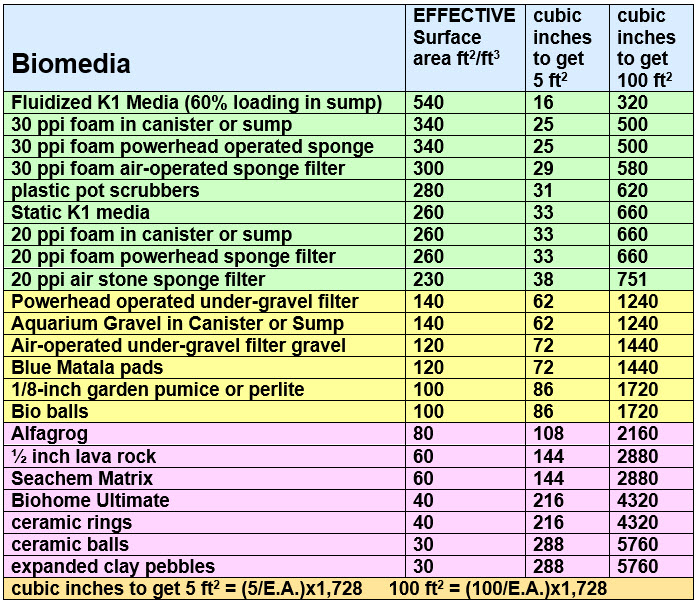
The media in green are the best media for optimizing surface area per cubic foot of media. For instance: a cubic foot of pot scrubbers can support 2.8 pounds of fish at the 100 square feet per pound level. A cubic foot of ceramic rings will only support 0.4 pounds of fish at the 100 square feet per pound level. That is a huge difference,
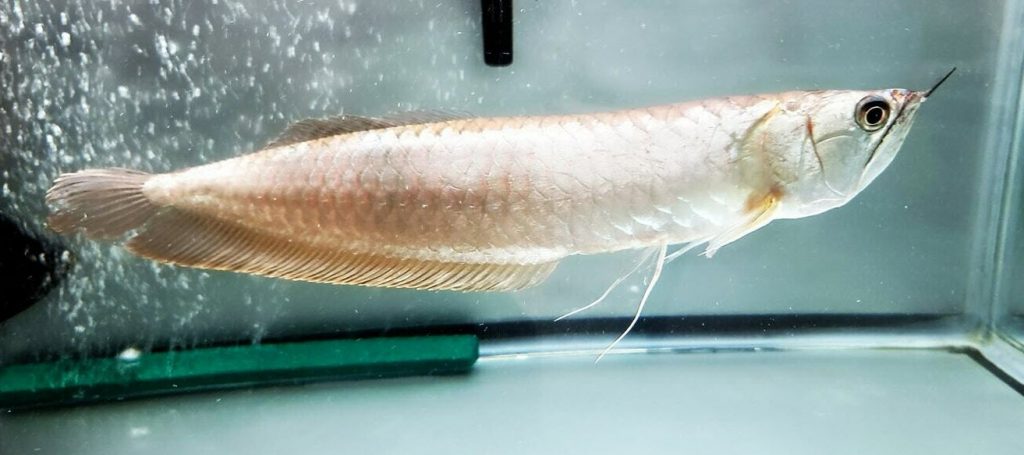
Other Variables
We need to emphasis that this analysis is extremely simplistic. There are a lot of variables that affect how well any biofiltration media performs. Some of those variables are:
1, Flow: There is a surprisingly small relationship with the flow rate. The faster the flow rate over the media the more it can help the fish. But this flow rate relationship is not as large as common mythology suggests. Doubling the flow rate only raises the filter rate by 9%. This number came from actual testing.
2, Opening size: the larger the opening in the media the longer the media can go without clogging up. Conversely, the larger the opening the lower the surface area. So this is a somewhat two edged sword that seems to be very roughly maximized at about one tenth to one eighth of an inch (2.5 to 3 millimeters).
3, Stocking: the heavier the stocking the faster the media will clog up. What is often missed is that beneficial nitrifying bacteria can be out competed for space by non-beneficial bacteria. The heavier the stocking the more this will occur. This will reduce the media efficiency even when unclogged.
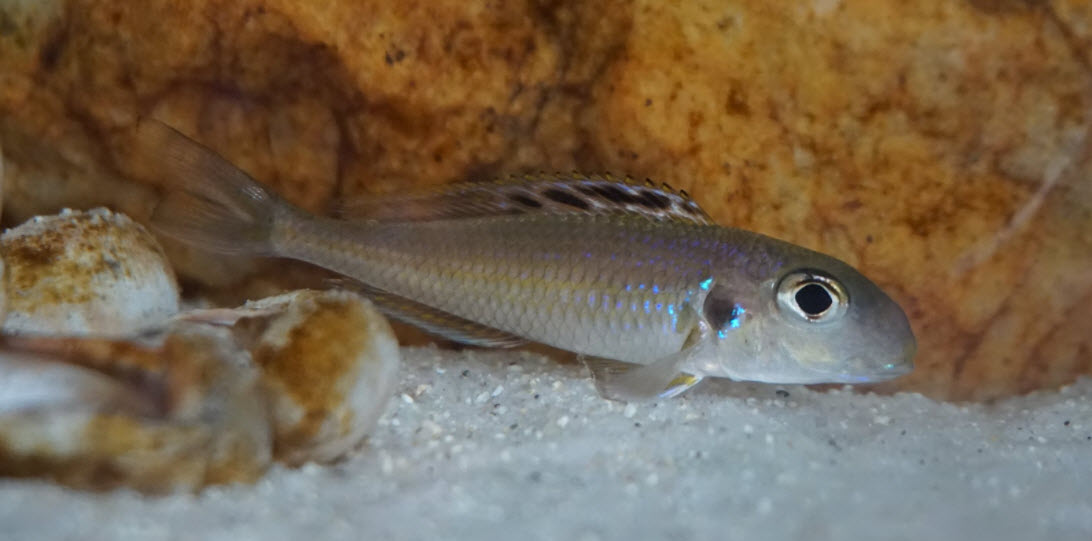
4, Amount of food: this is like the stocking variable. If a given stocking of fish is fed at a three percent of body weight per day level the media will be much less effective and clog up faster than if the feeding is at the one percent level.
5, Maturity: The longer filter media have been in place without cleaning the more “mature” the filter media and the better it will perform. This will be true until the flow slows down due to clogging.
6, Food protein levels: this interesting variable says that high protein food is much better for the filter than a low protein food. A 50% protein level food will give two and a half times the efficiency and the time to clog than will a 30% protein food. This desirability of high protein food has to do with biomass buildup rate and the carbon to nitrogen ratio of the food. Biomass will buildup much faster and have less exposed beneficial bacteria with a low protein food.
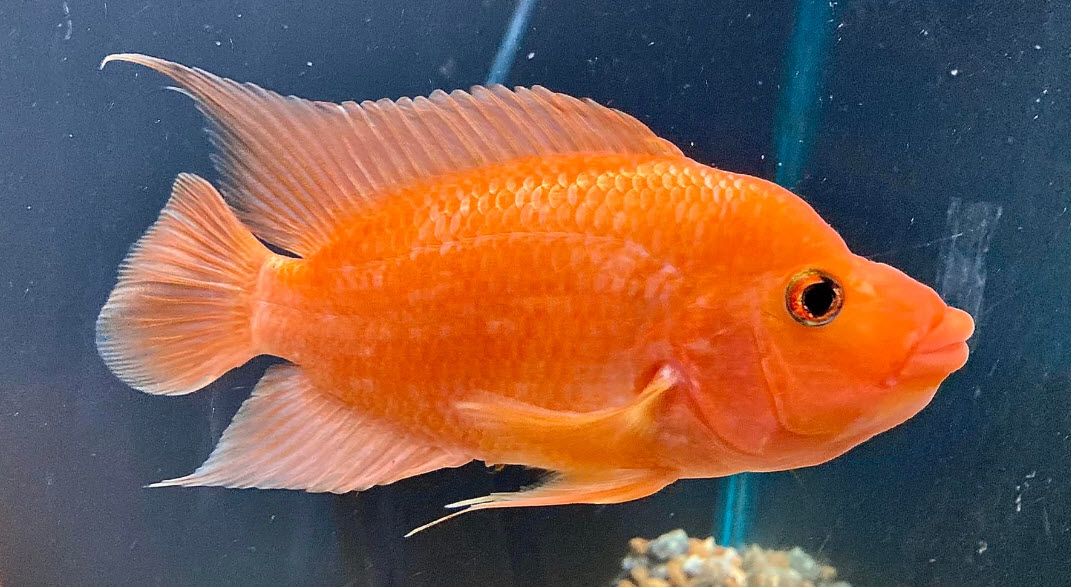
7, Aeration: the better the aeration the better the media will perform. The aeration in an aquarium provides oxygen to the beneficial bacteria. Good aeration aids both in the breakdown of ammonia and in the breakdown of dissolved organic compounds and lessens the clogging.
8, Free volume: the greater the free volume the more space is available for brown gunk to form and do biofiltration
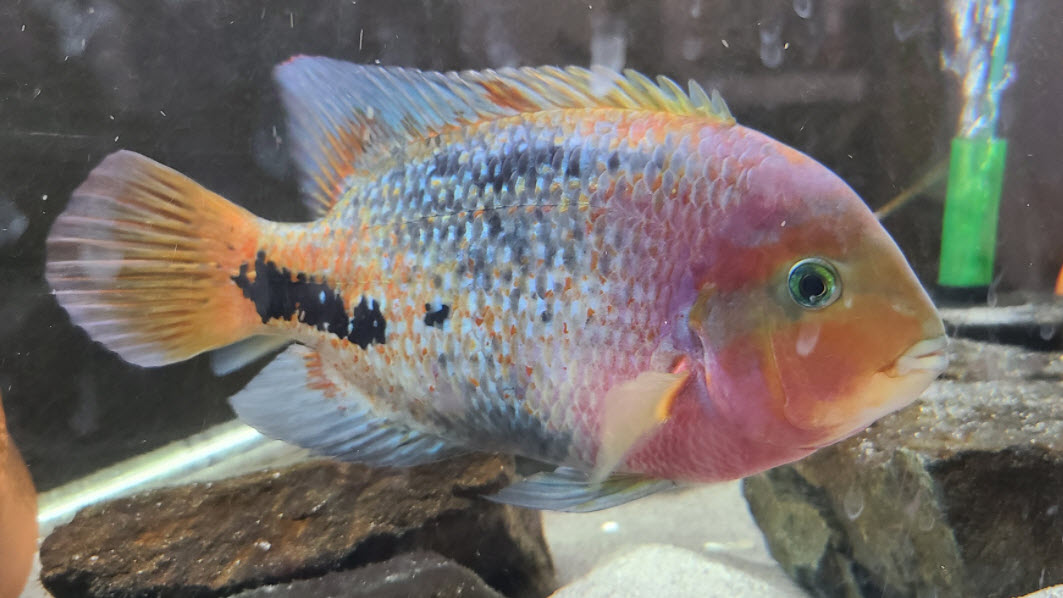
9, Temperature, pH, KH, GH and phosphates in the water all affect it in very unpredictable ways
10, Ecology: And the “ecology” of the tank will vary, often in very surprising ways. The tiny single celled protozoan community is surprisingly important to the function of an aquarium filter and the composition of this community varies in the extreme from tank to tank.
11, pH: Biofiltration capacity is somewhat dependent on pH. If you have an acidic aquarium of pH of 6.5 triple the number. If your pH is 6.0 multiply the number by 10. Acid conditions need much larger surface areas than a 7.0 to 8.4 pH.
All these things are cumulative and can rarely make a 10 square feet per pound filter give crystal clear water. By the same token they can rarely make a 500 square feet per pound filter give cloudy water.
This somewhat unpredictable variation is why I put a downright ridiculous amounts of filtration on all my tanks. My big tanks all have large K1 fluidized bed sumps and multiple undergravel filters on them. Some of the smaller tanks have FX6 canisters on them. I almost NEVER clean a filter. And the water is crystal clear and the fish are very healthy despite being very heavily stocked.
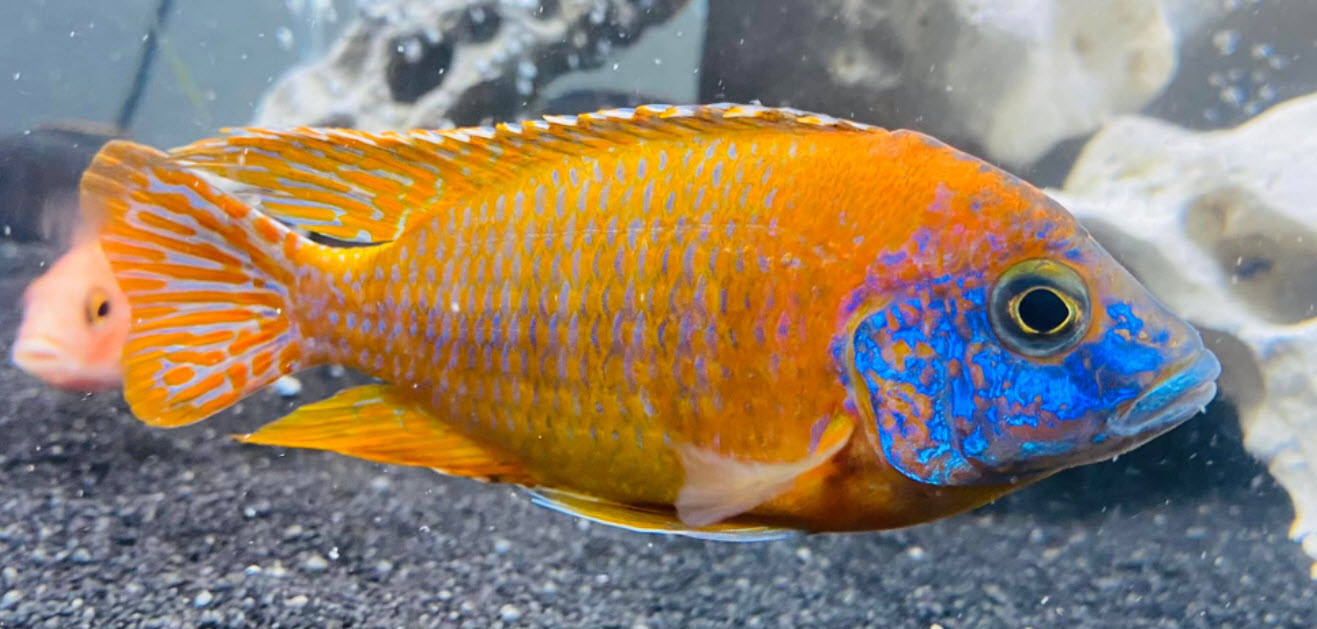
Illustrations on How to Apply the Surface Area Numbers
Here is a comment to this web page and its answer:
“Paul
I have a 75-gallon community tank with an EHEIM 2217 canister filter. I’m planning to replace all the EHEIM filter media with Swiss Tropical 20 PPI Poret foam. I’m thinking of having 5 foam pads, each 2” thick and 7” in diameter. Would this give me the 220 sq. ft of effective surface area mentioned in your chart? Using one of your other charts, I calculate that I have 0.75 lbs of fish. Using the 100 sq. ft for 1 lb. of fish metric, I would think I’ll be able to easily accommodate more fish – is that right? I’m planning to use your recommendation to squeeze liquid from the existing filter pads onto the new pads to jump start the cycling of the new foam. How long do you think I should wait before adding more fish? Thanks for your help.
Dave
OK you have a cylinder ten inches tall and 7 inches in diameter. V = π r2 h = π x 3.5 x 3.5 x 10 = 384 This will give one 384 cubic inches of 20 ppi foam. 12x12x12 is 1,728 So you will have 384/1,728 or 0.222 cubic feet. 0.222 x 220 = 49 square feet. So you can do 0.49 pounds of fish at the 100 square foot per pound of fish metric. At the current time you are at (0.49×100)/0.75 = 65 square feet per pound of fish. 65 square feet is good, but it isn’t 100 square feet. So you cannot accommodate more fish.
And you can add fish right away and just not feed them for a few weeks or wait literally as long as you are comfortable with. I add pond mud (see the article on the “mature aquarium”) and wait at least six weeks minimum but I’m a little nuts.
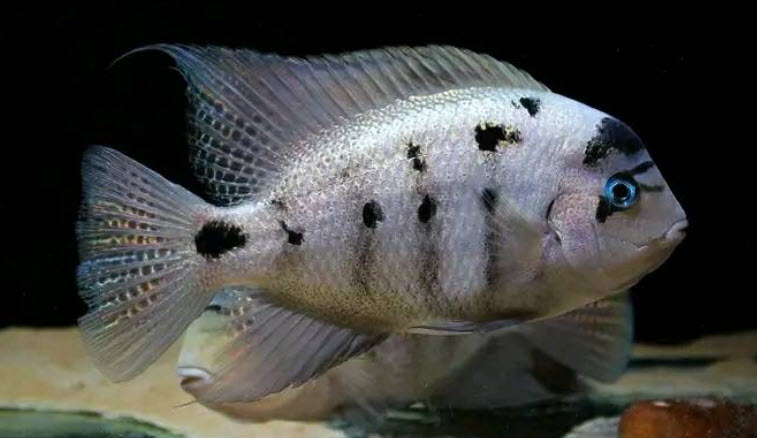
Another Example of Aquarium Filter Media Calculations
This exchange is from the comments section of this website:
Question #1
“Hi there,
I’m reaching out for some clarity on ‘Square Feet of Biomedia Surface Area’. I’m considering the 5″ Poret® Foam Sheets (26 × 19.5″ Sheet) and am wondering what the calculations would be for cubic sq. ft.? I plan on executing the ‘10 ft2/gallon of water’ OR ‘100 ft2/pound of fish.’”
Answer #1
“To calculate the volume the math is 5 inch x 26 inch x 19.5 inch / 12 inch x 12 inch x 12inch = 1.47 cubic feet per sheet of Poret® Foam. With a 20 ppi Poret® foam (what I recommend) which has about 220 square feet of effective surface area per cubic foot, this is 1.47 x 220 = 323 square feet. So If you use the whole sheet of Poret® you can support roughly 3.23 pounds of fish in a healthy environment (100 square feet of surface area per pound of fish). And I don’t recommend “10 ft2/gallon of water”. Go ONLY with the “100 ft2/pound of fish”.
Question #2
“Thank you so much for the reply but I’m still confused. Essentially I’m wondering how many – 5″ deep x 26″ long x 19.5″ high Poret® Foam Sheets, will I need for 13.2 lbs. of fish (24 × 8.8 oz Discus or 24 x 8.8/16)?”
Answer #2
“The calculation for 13.2 pounds of fish is 13.2 pounds divided by 3.23 pounds equals four sheets of 5″ deep x 26″ long x 19.5″ high Poret® Foam”
These examples illustrate the process very well.
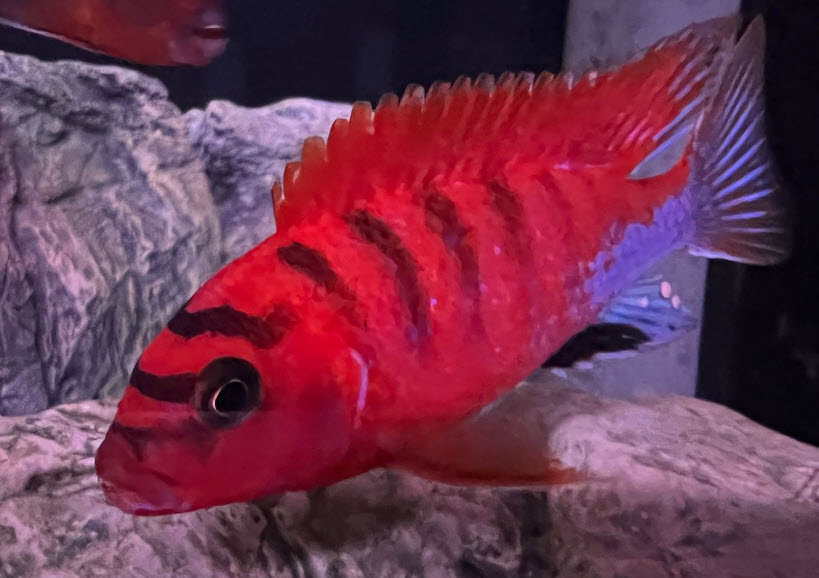
Sump Considerations
If one is doing the calculations for a sump one should be aware that fluidized bed K1 is roughly 58% more efficient than static 30 ppi foam as far as filtration. The effective surface area considerations are that fluidized K1 is 900 square feet per cubic foot of media. At 60% loading this becomes 540 square feet per cubic foot of sump filter.
Foam with 30 pores per inch has a surface area of 340 square feet per cubic foot. 540/340= 1.58
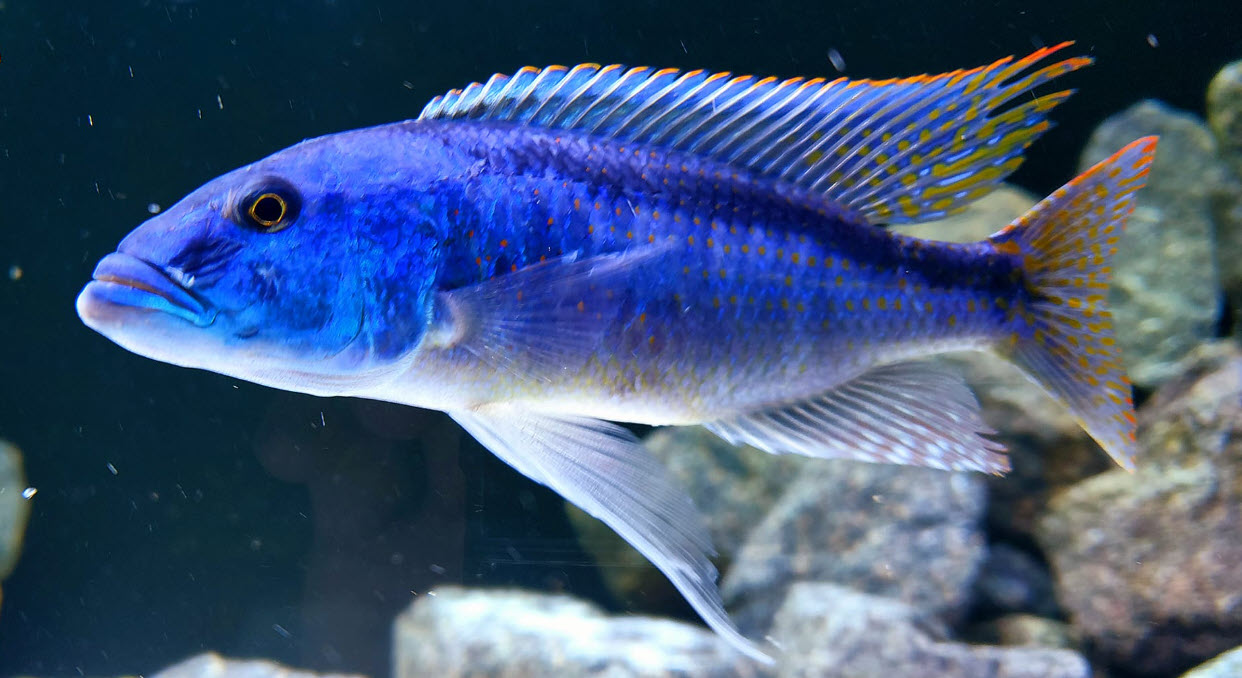
Still another illustration:
Question:
How do you calculate the surface area in media used for biological filtration? For example, I have 30 pot scrubbers and some foam in a Fluval 407 canister filter on a 75 gallon tank.
Reply
OK Each pot scrubber is roughly nine cubic inches of media (large pot scrubbers???). (9×30)/(12x12x12) = 0.156 cubic feet. Pot scrubbers are 280 square feet per cubic foot media. 0.156 x 280 = 44 square feet from the pot scrubbers. If I remember right a 407 has a piece of 30 ppi foam that is 10 inches x 1 inch x 14 inches. (10x1x12)/(12x12x12) = 0.081 cubic feet. 30 ppi Foam is about 340 square feet per cubic feet 0.081×340 = 27.5 square feet. 27.5 + 44 = 71.5 square feet. That is just off the top of my head. You need to correct the numbers depending on the size of your pot scrubbers and the true size of the 407 foam.
More In-depth Articles
For more on how to calculate filter volume go to these articles:
8.8. Filter and Media Design
8.8.1. Sizing Filters in Depth
7.3. Media Volume
.
Return to Filter Media Menu
.
Aquarium Science Website
The chapters shown below or on the right side in maroon lead to close to 400 articles on all aspects of keeping a freshwater aquarium. These articles have NO links to profit making sites and are thus unbiased in their recommendations, unlike all the for-profit sites you will find with Google. Bookmark and browse!
.

Dave says
In reply to Lissa ….. INITIALLY K5 is better than K1. Then, after a few months, the K5 plugs up with gunk and stops working as well as the K1. In other words the K5 isn’t self cleaning. The openings are too small.
Lissa says
Is k5 better than k1? Or is this just marketing hype….
Here is the description of k5
:Description
K5 is the newest model Bio Media Plus and has an unprecedented surface are greater than 3,500 m2/m3!
Bio Media Plus has been one of the most well documented biological solutions for the treatment of water for ponds, aquariums, and waste water. K5 bio media is perfect for DIY applications like moving bed filter applications and is research proven to be efficient. K5 bio media provides greater than 3,500 m2/m3 of surface area for the growth of beneficial bacteria to colonize making this media. With matured bacteria, this media is the efficient in removing ammonia and nitrites. K5 media is designed to be self-cleaning and to constantly move freely within your filter, requiring little to no maintenance. You may also utilize the media in a pressurized filter.
Bio Media Plus is suited for fluidized or moving bed tank systems. Typically, the bio media can support about 130 lbs of fish per 2 cubic feet of media, where fishes are fed 1.5% of their body weight per day. A safer measure is a maximum of 0.55 lb of food per 2 cubic feet used, in order to ensure the best possible water parameters are achieved. If you are unsure about which media to select please reference the above chart. Below you will find links to other Bio Media Plus models.
Phil B. says
Thank you so much for your insights!!! It will be stocked at half that effective biomass… school of white clouds, Hillstream loaches, bamboo and Amano shrimp… maybe a small school of panda garas.
Thanks again:-)
Dave says
In reply to Phil B. …. Using the methods shown in this article https://aquariumscience.org/index.php/7-6-media-surface-area/ and giving K5 the same surface area as K1 I come up with 1,164 square feet of surface area for your set-up. At 500 square feet per pound of fish this is over two pounds of fish (2.328 pounds of fish). I.e. a LOT of fish. Sounds like a very well thought out design. Go for it!
Phil B. says
My plan is to use 1 cubic ft of K5 material in a fluidized bed (at 60% with two power heads) 3 – 14.5 X 13 x 2 & 3 – 5 x13 x 2 30 DPI Poret sheets in a sump. To filter a 76 gallon hillstream set-up. The ” material” on the K5 suggests a crazy surface area, something like 5 times the K1. Have soft water pH 6.5, no CO2 in this set-up with moderate planting. How do I calculate my bio load to be at 500 sq/ft per pound of fish?
Thanks for your apparent very hard work on this site!!!!
Phil
Mark says
8.8.1 is the section I can’t get to that says page not found
Dave says
In reply to Mark … I’ve added a section to this article on calculating surface area. Hope it helps. What was the section that says “page not found”?
Mark says
I have changed most of my tanks over to under gravel filters and they work very well. Most of my tanks are lightly stocked right now but I haven’t been able to find the effective surface area of the gravel to do calculations for # of fish. There is a section that keeps saying page not found so I think that may be the page I need. If you could let me know that would be great.
Thanks, Mark
Dave says
In reply to scapesce Just a few recommendations
1, I would add an undergravel filter to your setup to insure crystal clear water
2, set it up as a planted tank only with only easy plants (Amazon sword, Java Fern, Java Moss, anubias)
3, In three to four months start adding your fish
4, Alternatively add the fish after fish less cycling of the aquarium and then add your plants after three to four months,
Read the first chapter of the website (for beginners), especially https://aquariumscience.org/index.php/1-1-10-plants-and-the-new-hobbyist/
Scapesce says
Hello, I’m a commenter from EU which is just starting the hobby and found your website extremely thorough and informative.
Unfortunately all the conversions from metric to imperial and my extremely low understanding of everything regarding fish keeping are making understanding most things a bit difficult and was wondering if you would be so kind to lend me some advice.
I’d like to set up a planted tank, already bought a 33 gallon tank (which will end up housing around 26 when all the decor has been set up I believe), I’ve also already purchased a filter looking at reviews/trying to wrap my head around all the info online, it’s an internal filter (sharkpro 700, I don’t know if I can name the product, sorry if not), and would like to house a good number of plants, 3 Pearl Gouramis, 4/5 Tateurndina Ocellicaudas, 3 Otocinclus and maybe a couple of Snails, would my filter (substituting all the media with 30ppi sponges) be ok for crystal clear water? Also any general very digested info would be gold for me. Thanks!
Brad - UK says
@MLopez
It’s all Dave, really!
There could be many reasons why you had clear water for a while (fish additions, cleaning frequency changes, etc.). Still, your filter is definitely undersized, uses media with poor surface area and cannot keep up with the inhabitants. Even if you converted your whole 0.7-litre media capacity to 30PPI foam, that would only support 2 x 3-inch fish with Crytal Clear Water.
Two great articles on this are:
https://aquariumscience.org/index.php/6-4-crystal-clear-water/
https://aquariumscience.org/index.php/6-4-1-crystal-clear-water-in-depth/
Good luck!
MLopes says
thank you so much Brad and Dave!
the wierd thing is that they were running very, very good with perfectly crystal clear water for more than 6 months and suddenly….
Dave says
In reply to Mlopes …. Can’t do a better job answering your questions than Brad did. Your filters are decidedly undersized with poor media.
Brad - UK says
@Mlopes
Until Dave gets back to you, he has written a great article which includes fish weight calculations. This can be found here; go down to the Simple Calculations section, which also has a table of Metabolic Weight.
https://aquariumscience.org/index.php/3-3-1-amount-in-depth/
You can use that table to calculate your fish weight – for example, one Betta fish is about 3 inches, so they are 22 metabolic grams each = 66 grams for 3 Bettas. Just add the rest of the fish in the same way to get the total for each aquarium.
According to the internet, your HOB 35 only has 0.7 litres of media capacity – which equates to 43 inches/3 of capacity. Even if that whole space was filled with 30PPI foam, that would only support around 40 grams of fish with Crystal Clear water. Just the Bettas alone exceeds that weight, so it may be why your water column is cloudy.
However, please wait for the expert to respond!
mlopes says
excelente work!
i’m stunned reading your findings but have also having some trouble since you don’t use metric in you calculations. i know i can convert it but…ggrrrr
and i really don’t know where to get my fish weight 😮
i have two tanks with cloudy water problems:
30x30x30cm with a betta male and two females and a cleaning crew (6xneocaridina davidi yellow, 3 clithon snails, 2 otocinclus affini, 3 pygmi corydora) working with an tidal 35 hob with one layer of 30ppi sponge, one layer of matrix an one layer of jbl symec on top. using 10 ppi sponges on inlet and surface skimmer to nothing gets caught by the filter)
30x30x30cm with 10 …., 6 galaxy rasbora, 2 otocinclus affini, 3 pygmi corydora using the same filter and media layout.
are tidal 35 too small regarding filter media capacity for these tanks?
Dave says
In reply to Tathagata …. Your calculations are pretty spot on. Do note that the Eheim 2217 is a small cannister filter. An FX6 loaded with 30 ppi foam can probably do four to five times that loading. And discus are even touchier than angels.
Tathagata says
Hi Dave, thanks a lot for confirming .
Biological weight of 4” Angels (Because the angelfish are tall one has to multiply 47 by 2) = 2*47 = 94 gms.
With Eheim 2217 canister : Media volume = 384 cubic inch = .222 cubic feet (from Paul’s answer V = π r2 h π x 3.5 x 3.5 x 10 = 384)
Effective surface area with 30 ppi foam = 0.222*340 = 75.48 square feet
Fish capacity as per the 100 sq, foot per pound rule = .75 pounds
.75 pounds in Grams = 340 grams.
So an Eheim 2217 with 30 PPI foam is only good enough for 4 Angels 4” in size if I want crystal clear water !!!
If this calculation is correct I am wondering what kind of filtration is used by people having large healthy Angels ? Can you think of any Youtube video ?
Also, is this true for Discus as well ???
Dave says
In reply to Tathagata … Yes, use the 340 figure.
Tathagata says
Hi Dave,
I can’t find the “220 sq. feet effective surface area” as mentioned in the question by Paul anywhere. As per the chart in Chapter 7 it’s 260 ( and not 220) for 20 PPI foam.
As per the same chart it’s 340 for 30 PPI foam…so can I use that ?